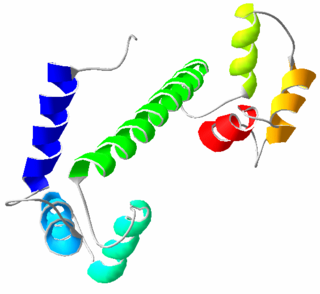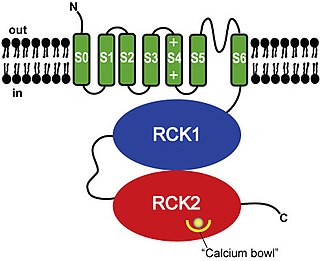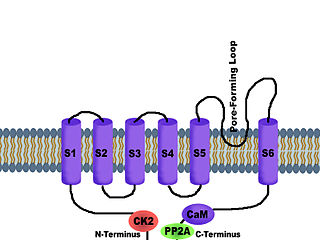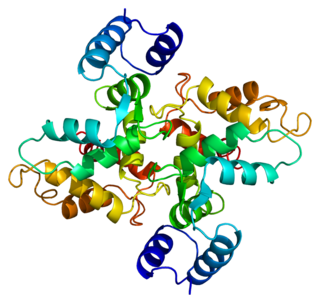Related Research Articles

Calmodulin (CaM) (an abbreviation for calcium-modulated protein) is a multifunctional intermediate calcium-binding messenger protein expressed in all eukaryotic cells. It is an intracellular target of the secondary messenger Ca2+, and the binding of Ca2+ is required for the activation of calmodulin. Once bound to Ca2+, calmodulin acts as part of a calcium signal transduction pathway by modifying its interactions with various target proteins such as kinases or phosphatases.

BK channels (big potassium), are large conductance calcium-activated potassium channels, also known as Maxi-K, slo1, or Kca1.1. BK channels are voltage-gated potassium channels that conduct large amounts of potassium ions (K+) across the cell membrane, hence their name, big potassium. These channels can be activated (opened) by either electrical means, or by increasing Ca2+ concentrations in the cell. BK channels help regulate physiological processes, such as circadian behavioral rhythms and neuronal excitability. BK channels are also involved in many processes in the body, as it is a ubiquitous channel. They have a tetrameric structure that is composed of a transmembrane domain, voltage sensing domain, potassium channel domain, and a cytoplasmic C-terminal domain, with many X-ray structures for reference. Their function is to repolarize the membrane potential by allowing for potassium to flow outward, in response to a depolarization or increase in calcium levels.

Hippocalcin is a protein that in humans is encoded by the HPCA gene.

Voltage-gated potassium channels (VGKCs) are transmembrane channels specific for potassium and sensitive to voltage changes in the cell's membrane potential. During action potentials, they play a crucial role in returning the depolarized cell to a resting state.

Neurocalcin is a neuronal calcium-binding protein that belongs to the neuronal calcium sensor (NCS) family of proteins. It expressed in mammalian brains. It possesses a Ca2+/myristoyl switch

SK channels (small conductance calcium-activated potassium channels) are a subfamily of Ca2+-activated K+ channels. They are so called because of their small single channel conductance in the order of 10 pS. SK channels are a type of ion channel allowing potassium cations to cross the cell membrane and are activated (opened) by an increase in the concentration of intracellular calcium through N-type calcium channels. Their activation limits the firing frequency of action potentials and is important for regulating afterhyperpolarization in the neurons of the central nervous system as well as many other types of electrically excitable cells. This is accomplished through the hyperpolarizing leak of positively charged potassium ions along their concentration gradient into the extracellular space. This hyperpolarization causes the membrane potential to become more negative. SK channels are thought to be involved in synaptic plasticity and therefore play important roles in learning and memory.

Neuronal calcium sensor-1 (NCS-1) also known as frequenin homolog (Drosophila) (freq) is a protein that is encoded by the FREQ gene in humans. NCS-1 is a member of the neuronal calcium sensor family, a class of EF hand containing calcium-myristoyl-switch proteins.

Kv7.2 (KvLQT2) is a volatage- and lipid-gated potassium channel protein coded for by the gene KCNQ2.

Kv7.3 (KvLQT3) is a potassium channel protein coded for by the gene KCNQ3.

Calsenilin is a protein that in humans is encoded by the KCNIP3 gene.

Potassium voltage-gated channel subfamily D member 2 is a protein that in humans is encoded by the KCND2 gene. It contributes to the cardiac transient outward potassium current (Ito1), the main contributing current to the repolarizing phase 1 of the cardiac action potential.

Kv channel-interacting protein 2 also known as KChIP2 is a protein that in humans is encoded by the KCNIP2 gene.

Visinin-like protein 1 is a protein that in humans is encoded by the VSNL1 gene.

Hippocalcin-like protein 1 is a protein that in humans is encoded by the HPCAL1 gene.

Voltage-dependent L-type calcium channel subunit beta-1 is a protein that in humans is encoded by the CACNB1 gene.

DnaJ homolog subfamily C member 5, also known as cysteine string protein or CSP is a protein, that in humans encoded by the DNAJC5 gene. It was first described in 1990.

Kv channel-interacting protein 1 also known as KChIP1 is a protein that in humans is encoded by the KCNIP1 gene.

Potassium voltage-gated channel, Shal-related subfamily, member 1 (KCND1), also known as Kv4.1, is a human gene.

Kv channel-interacting protein 4 is a protein that in humans is encoded by the KCNIP4 gene.
Kv channel interacting proteins are members of a family of voltage-gated potassium (Kv) channel-interacting proteins, which belong to the recoverin branch of the EF-hand superfamily. Members of the KCNIP family are small calcium binding proteins. They all have EF-hand-like domains, and differ from each other in the N-terminus. They are integral subunit components of native Kv4 channel complexes. They may regulate A-type currents, and hence neuronal excitability, in response to changes in intracellular calcium. Alternative splicing results in multiple transcript variant encoding different isoforms.
References
- ↑ Burgoyne RD (2007). "Neuronal calcium sensor proteins: generating diversity in neuronal Ca2+ signalling". Nat. Rev. Neurosci. 8 (3): 182–193. doi:10.1038/nrn2093. PMC 1887812 . PMID 17311005.
- ↑ Burgoyne RD, O'Callaghan DW, Hasdemir B, Haynes LP, Tepikin AV (2004). "Neuronal Ca2+-sensor proteins: multitalented regulators of neuronal function". Trends Neurosci. 27 (4): 203–9. doi:10.1016/j.tins.2004.01.010. PMID 15046879. S2CID 24156457.
- ↑ Weiss JL, Hui H, Burgoyne RD (2010). "Neuronal calcium sensor-1 regulation of calcium channels, secretion, and neuronal outgrowth". Cell. Mol. Neurobiol. 30 (8): 1283–92. doi:10.1007/s10571-010-9588-7. PMID 21104311. S2CID 2270302.
- ↑ Tsvetkov, PO; Roman, AY; Baksheeva, VE; Nazipova, AA; Shevelyova, MP; Vladimirov, VI; Buyanova, MF; Zinchenko, DV; Zamyatnin AA, Jr; Devred, F; Golovin, AV; Permyakov, SE; Zernii, EY (2018). "Functional Status of Neuronal Calcium Sensor-1 Is Modulated by Zinc Binding". Frontiers in Molecular Neuroscience. 11: 459. doi:10.3389/fnmol.2018.00459. PMC 6302015 . PMID 30618610.